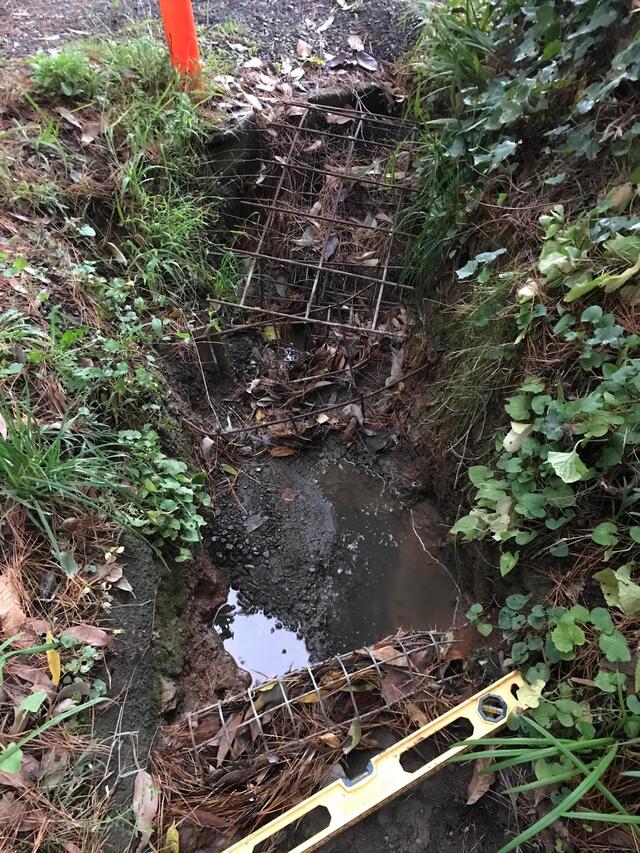Residents in Olinda have been frustrated with the deteriorating condition of the road in Thomson Avenue, pushing one of the residents to make several complaints to the Yarra Ranges Council.
There are four houses in that street, the poor conditions of the road have created unique issues for all of them.
Alan Rogers has made multiple enquiries and complaints to the council for the past four years.
His house is at the bottom of the road and said everything that gets washed away from the top, ends up blocking his drains, resulting in water flooding his garden and front yard.
Upper Coonara Road is the road above Mr Roger’s street, during a sudden storm or heavy rain, it gets eroded easily.
Mr Rogers’ main concern is that the drains fill up with the road metal, it also blocks up with the branches and leaves, this then flows down into their drains and causes erosion and damages to the residents’ property.
“My biggest beef with the council is the frustration of them not taking the problem seriously,” Mr Roger said.
“We are at the end of Thomson Avenue, it’s a small street…we have to take our own bins up, we have to go to the top of the street to get the mail, we hardly see the grader, they come twice a year to lay gravel on the road…we are at the end of the truckload, so as a consequence, our road gets no attention.
“We are greatly affected by the effects of what goes on above us.”
He has been contacting the council on numerous occasions in hopes of fixing the problem, but he said the council doesn’t appreciate it or doesn’t seem to want to know what the problem is with the engineering up on the road not the houses below it.
A Yarra Ranges Council spokesperson said drainage inspections have taken place but given the location, it was suitable infrastructure.
“This open drain takes large volumes of water during heavy rainfall, and it is important that landowners pro-actively maintain the driveways where it meets Councils road and the drainage system,” they said.
“Due to the changes in weather patterns and increased rainfall in recent years, Council acknowledges that drainage, particularly on properties in a steep locations, will be experiencing challenges.”
When Mr Rogers bought the house nearly a decade ago, he was aware of the responsibility of taking the bins up on the street, but over time, the mailman stopped delivering parcels to their house because the vans got stuck going uphill and now the residents are concerned because if someone gets sick, no ambulance or health care workers can access their street easily and comfortably.
“We’ve had a number of delivery vans, they get stuck, and we have had to rescue them – I have towed a number of cars because they can’t get up the road,” he said.
“There is a priority on how you treat people, life and limb becomes a prime priority, they should be doing something about that.”
The small section of Mr Rogers’ street is quite steep, during the rainy season, it gets eroded quickly, which then traps people living down that street.
Mr Rogers said he’s lucky because both him and his wife have four-wheel-drive (4WD) cars, but for anyone going up and down that roadway without a 4WD, it can turn into a nightmare.
Mr Rogers is a retired engineer, he said he understands the hierarchy of priorities, but on multiple occasions the response he has received has been quite condescending.
“I received a letter from a stormwater engineer nearly a year ago, it was very condescending – indeed patronising – to dismiss my concerns as not important,” he said.
“I have yet to respond to his letter, I initially chose to ignore the letter but with the latest damage there is now a case for me to respond.”
“I don’t like being patronised by young engineers, who are quoting from a textbook, and do not bother to come out to look and listen at the priorities or at the problem that exists.”
His house has been affected three times during the wetter forecast, resulting in the damage of his driveway, which cost him thousands of dollars.
Thomson Avenue is a cul-de-sac street, surrounded by tall trees, in case of fire or other emergencies, it puts the lives of the residents at risk.
For many years, the street wasn’t correctly mapped on Google Maps – at one stage it was propagated as a through road.
“We’re paying our full rates and taxes just like anyone who may live on a fully sealed road, but without everything that works,” he said.
“The council has responsibilities, and they’re just paying lip service.”
He said he hasn’t been critical but rather in a number of suggestions, he’s been constructive.
“I’ve said to [the council], to create an inspection regime that you can send an engineer out after a big major storm or regularly….maybe four times a year, especially after poor weather to do your inspection, you can inspect the drains, you can inspect the state of the road, and then act accordingly,” Mr Rogers said.
Thus far, he has carried out stormwater mitigation on his own in order to control the water flow in the stormwater but he said he still gets impacted.
“I would like the council to come out and do the clearing of their road base, it’s not mine,” he said.
“Three years ago, my neighbour was suffering from cancer and the ambulance could not get down to his property because the road was so bad most of the time.”
Sue Stopar, Mr Rogers’ neighbour, had her home flooded three years ago.
“I stepped out of bed and the carpet was very wet, the floors and carpet was covered with muddy water,” she said.
The council had been down on Friday – the day before Ms Stopar’s house flooded, but they were meant to come on Thursday, two days prior to the flooding.
“They saw how everything was blocked – both near my crossover and the one above it, and they mentioned there was major engineering work that needed to be done,” she said.
Ms Stopar contacted Yarra Ranges Council to notify them about the damages she endured from the stormwater overflow.
The council replied to her email that major engineering works would need to be done at the top of the road, but nothing would be done until later in the year.
Nothing has been done to this date.
In the email she stated that her home was inundated with muddy water in the early hours of Saturday 5 March 2022.
While waiting to hear back from the council, she rang her insurance company and they referred the inundation of water to both a building company and to a contents restorer company.
They sent an electrician to check power points and power boards that afternoon.
Power points appeared ok but not power boards and she was told not to use them.
On Tuesday 8 March a representative from the building company came to assess damage to timber flooring in the kitchen and family room.
Ms Stopar said the floor was buckled in areas, one being by a door leading to the outside, that door couldn’t be closed at all.
Some skirting boards, door jambs, kick board under kitchen cupboards, panels on a bathroom cupboard all needed to be replaced, as well as the timber floor itself.
She said that same day two men from the contents restorer came and ripped up wet carpet and underflow from all rooms, including two bedrooms, study, dining room and hallway.
“Thankfully that was all covered by the insurance,” she said.
“I got some money from the insurance to replace some of it, however, I paid a little bit more, because I thought rather than getting a veneered chest of drawers like I had or cabinet, I’d get something more solid, because if it happened again, there was less chance of being splitting and I have to get rid of it.”
The damage was causing a lot of health concerns because of the growing mould.
Ms Stopar had to leave her home for six weeks while her insurance was fixing and repairing her home.
All this happened during a time when Ms Stopar’s husband was battling cancer.
Ms Stopar and her late husband moved into their home in September 1996.
When Mr Stopar was alive and well, he would clear out the culvert at times when it was blocked with road gravel, leaves, branches and had not been marked for maintenance by the council.
The council spokesperson confirmed that “from time to time” driveways and access points may need to be cleaned by residents, because “as the area is heavily treed, leaf and tree debris can build up and there are times when this can be problematic”.
After Mr Stopar’s passing and with Ms Stopar’s coping with a back injury, she’s not able to do as much as she would like to do.
“Since the flooding that changed my whole house, I’ve paid $1600 to have a Mediterranean drain along the driveway…we’ve had one there before, but when the water came in, all the gravel filled up the drain,” Ms Stopar said.
“If water comes into the property, I hope it goes along the driveway rather than over the lawn and over the house.”
Both Mr Rogers and Ms Stopar have put in multiple requests for the council to clear the table drain so that the water can go underneath their street rather than above it which damages their road and property.
“I think it would be good if [the council] started to address old and unresolved problems, new problems are going to keep coming up all the time, but they should try and address the ones that people have been waiting for for years,” Ms Stopar said.
“When I know that we’re going to get heavy rain, I don’t sleep that well.”
“There is that fear and anxiety, because I don’t want to go through all of that again and I don’t want to don’t want to leave here, because this is home.”
Ms Stopar said the residents in Thomason Avenue have been waiting long enough to be informed what is going on.
The spokesperson said Yarra Ranges Council officers “will contact the resident on Thomson Avenue and work with them to provide advice on how to mitigate their property from the impact of natural overland flow.”












